What to Do With Leftover Tomatoes
Don't let those leftover tomatoes go to waste! You've got plenty of delicious options to make the most of them. Transform your tomatoes into a rich roasted sauce, whip up a fresh salsa or bruschetta, or blend them into a chilled gazpacho. For longer-term storage, consider making tomato jam or chutney, or freeze them for future use. You can even create homemade tomato powder for a versatile seasoning. If you're feeling adventurous, try your hand at tomato-based cocktails or stuffed tomatoes. With these ideas, you'll never look at leftover tomatoes the same way again. There's a whole world of tomato-based culinary creativity waiting to be explored.
This post may contain affiliate links. If you make a purchase through these links, I may earn a commission at no additional cost to you. Additionally, portions of this post may be generated using artificial intelligence (AI) technology. While we strive for accuracy, please be aware that AI-generated content may not always be perfect and should be fact-checked when necessary.
The Spatula Scoops
- Make roasted tomato sauce to intensify flavor and create a versatile base for various dishes.
- Prepare fresh salsa or bruschetta for quick appetizers or toppings using diced tomatoes and herbs.
- Blend leftover tomatoes into a chilled gazpacho soup for a refreshing, no-cook summer meal.
- Create tomato jam or chutney to preserve tomatoes and add unique flavors to sandwiches and curries.
- Freeze raw tomatoes, sauces, or pastes for future use in soups, stews, and other cooked dishes.
Roasted Tomato Sauce
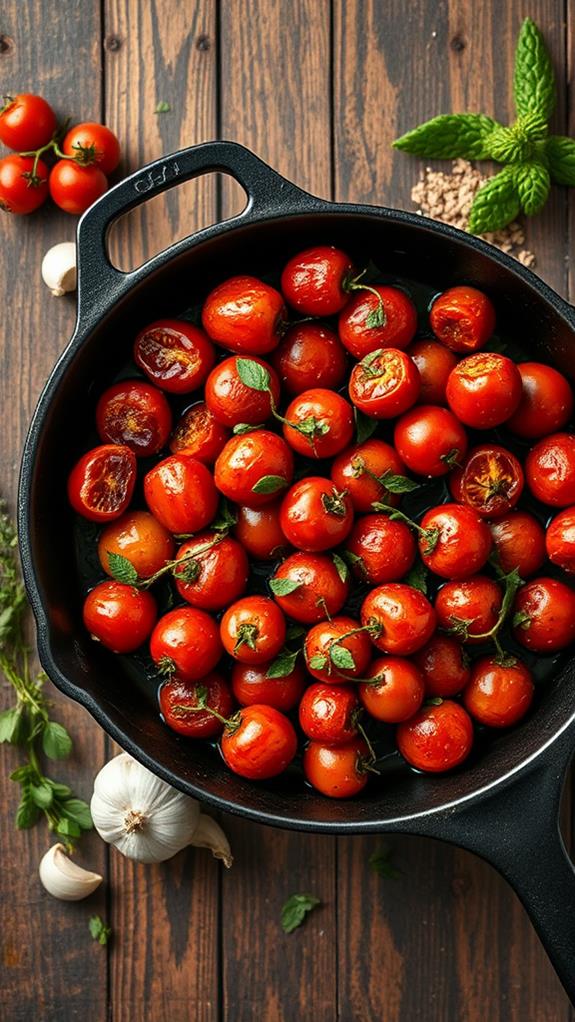
Roasted tomato sauce is a flavor-packed solution for using up leftover tomatoes. This simple cooking method intensifies the natural sweetness and flavor of your tomatoes, creating a rich, concentrated sauce that's versatile and delicious. To make this sauce, you'll need to slice your tomatoes and garlic, drizzle them with oil, and roast them until the skins loosen. Raw corn enthusiasts might appreciate the similar process of transforming simple ingredients into flavorful dishes. Like raw corn, roasted tomatoes retain more of their nutrients compared to other cooking methods.
One of the benefits of this technique is that you can use the entire tomato, including the flavorful tomato water, which is often discarded in other sauce-making processes. For best results, consider using roma tomatoes, as they don't produce excess water when roasted, resulting in an intensely flavored sauce without excess liquid.
Once your roasted tomatoes are ready, simply combine the pulp and water to create a versatile sauce that can be used in various dishes. This method is not only easy and convenient but also guarantees that you're making the most of your leftover tomatoes. By roasting them, you're transforming ordinary tomatoes into a sauce bursting with concentrated flavor, perfect for elevating your cooking and reducing food waste.
Tomato Salsa and Bruschetta
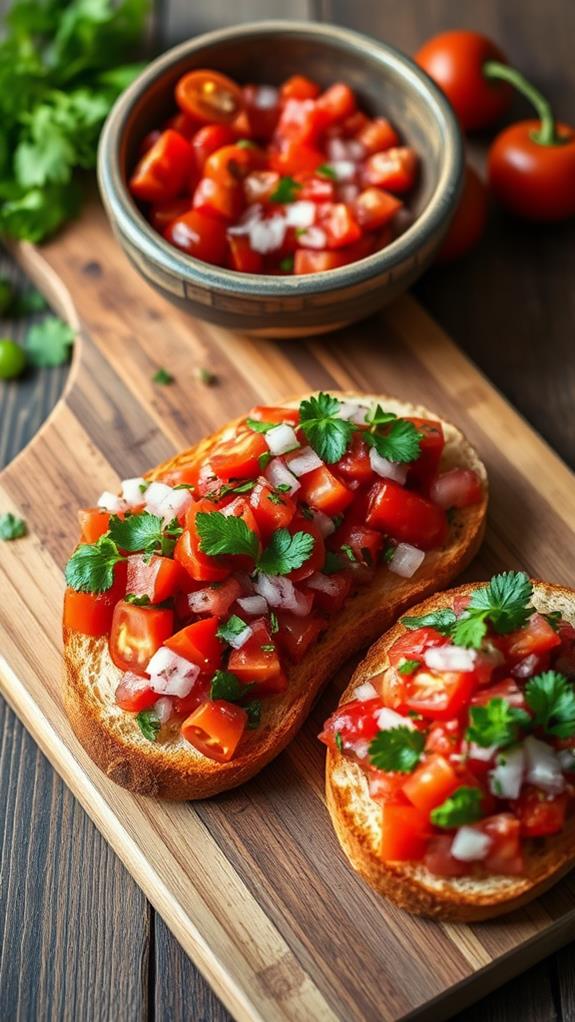
You'll find that tomato salsa and bruschetta are quick and easy recipes that make the most of your leftover tomatoes. These fresh flavor combinations allow you to create appetizers, sides, or toppings in no time, showcasing the natural sweetness and acidity of ripe tomatoes. For an extra nutrient boost, consider incorporating strawberry leaves into your salsa or bruschetta mix, adding a unique earthy flavor and increasing the antioxidant content. Whether you're serving chips with zesty salsa or topping crusty bread with fragrant bruschetta, you'll have versatile options that are sure to impress your guests or add a burst of flavor to your meals.
Quick and Easy Recipes
When life hands you a bounty of tomatoes, quick and easy recipes come to the rescue. Two delicious options that'll help you use up those fresh tomatoes are salsa and bruschetta. These no-cook dishes are perfect for showcasing ripe, flavorful specimens and can be whipped up in no time.
For a fresh salsa that's easy to make, combine diced tomatoes with onions, chilies, lime juice, and cilantro. This versatile condiment works great as a topping for grilled meats, a dip for chips, or a zesty addition to tacos. You can use both ripe and slightly underripe tomatoes, making it an excellent choice for using up your entire harvest.
Bruschetta, another simple yet delicious option, features sliced tomatoes, basil, garlic, and balsamic vinegar atop grilled or toasted bread. It's a classic appetizer that lets the natural flavors of your tomatoes shine. Both salsa and bruschetta are incredibly adaptable, serving as appetizers, snacks, or side dishes. They're not only tasty but also practical solutions for utilizing a surplus of tomatoes, ensuring none go to waste.
Fresh Flavor Combinations
Salsa and bruschetta offer endless possibilities for fresh flavor combinations. These versatile dishes allow you to experiment with different herbs, spices, and ingredients to create unique taste profiles. When making tomato salsa, you'll combine ripe tomatoes with onions, chilies, cilantro, and lime juice. This classic recipe serves as a foundation, but don't hesitate to add your own twist. Try incorporating diced mango for sweetness or roasted corn for a smoky flavor.
For bruschetta, you'll start with toasted bread as your base. Spread a mixture of diced tomatoes, garlic, fresh basil, and olive oil on top. To elevate the flavor, consider adding balsamic vinegar or crumbled feta cheese. Both salsa and bruschetta are excellent ways to use up leftover tomatoes while reducing food waste.
These dishes require minimal cooking and can be prepared quickly. They're perfect as appetizers, side dishes, or toppings for various meals. By utilizing fresh, ripe tomatoes in these recipes, you'll enhance their natural sweetness and acidity. Remember, the key to great salsa and bruschetta lies in using high-quality, fresh ingredients and balancing flavors to suit your taste preferences.
Versatile Serving Options
The versatility of tomato salsa and bruschetta extends far beyond their traditional roles as appetizers. You'll find these dishes are perfect for using up leftover tomatoes while adding zest to various meals. Whether you're working with raw or cooked tomatoes, salsa can be your go-to solution. It's not just for tacos and nachos; try it on grilled meats or mixed into scrambled eggs for a flavor boost.
Bruschetta, featuring sliced tomatoes atop crunchy bread, offers another delicious option. You can customize both salsa and bruschetta with herbs, spices, and vinegars to suit your taste preferences. These dishes are also ideal for meal prep, as you can make them ahead of time for quick weeknight dinners or entertaining guests.
Don't let any leftovers go to waste. Repurpose your salsa or bruschetta in pasta dishes or as a topping for a savory tomato tart. By incorporating these versatile serving options into your culinary repertoire, you'll minimize food waste while maximizing flavor. Remember, the key to great tomato dishes lies in balancing flavors and textures, so don't be afraid to experiment with different combinations.
Chilled Gazpacho
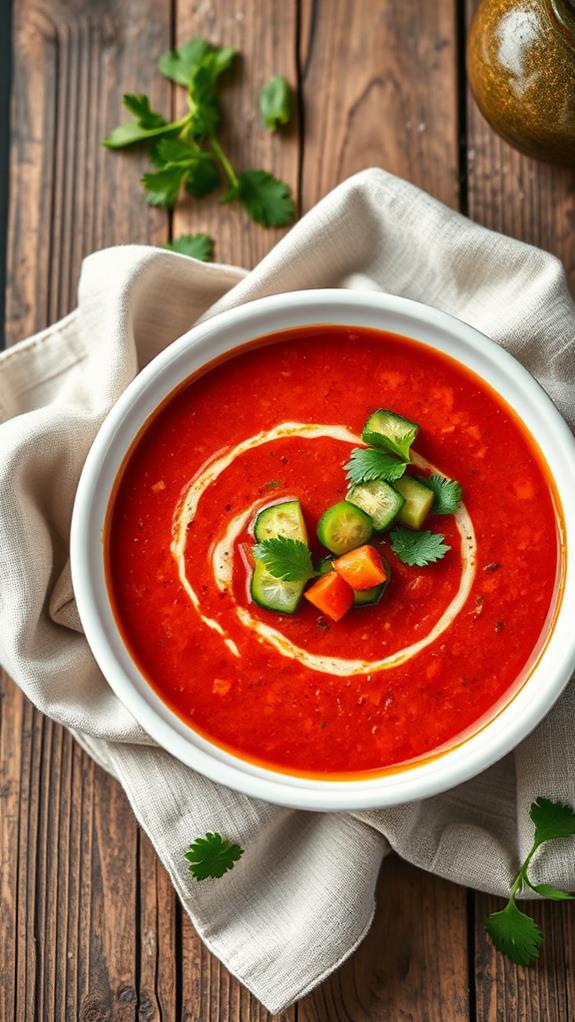
Chilled gazpacho offers a delightful solution for your leftover tomatoes. This Spanish-inspired soup is perfect for using up a surplus of ripe tomatoes during peak season. You'll combine your tomatoes with other fresh vegetables like cucumber, onion, and bell pepper to create a revitalizing, no-cook dish that showcases the flavors of summer. Gazpacho is not only delicious but also packed with nutritional benefits, including high levels of vitamins A and C, which support immune function and overall health.
To make gazpacho, you'll need to:
- Blend your tomatoes with other vegetables and seasonings
- Chill the mixture thoroughly before serving
- Customize the soup with herbs and spices to suit your taste
Use your food processor or blender to create a smooth, well-combined mixture. The beauty of gazpacho lies in its versatility; you can adjust the ingredients and seasonings to match your preferences. Don't be afraid to experiment with different herbs or add a touch of heat with some chili peppers.
This easy-to-make soup is not only a great way to use up your leftover tomatoes, but it's also a nutritious and invigorating option for hot summer days. Serve your chilled gazpacho as a light lunch, appetizer, or even as a unique cocktail base for a twist on the classic Bloody Mary.
Tomato Jam and Chutney
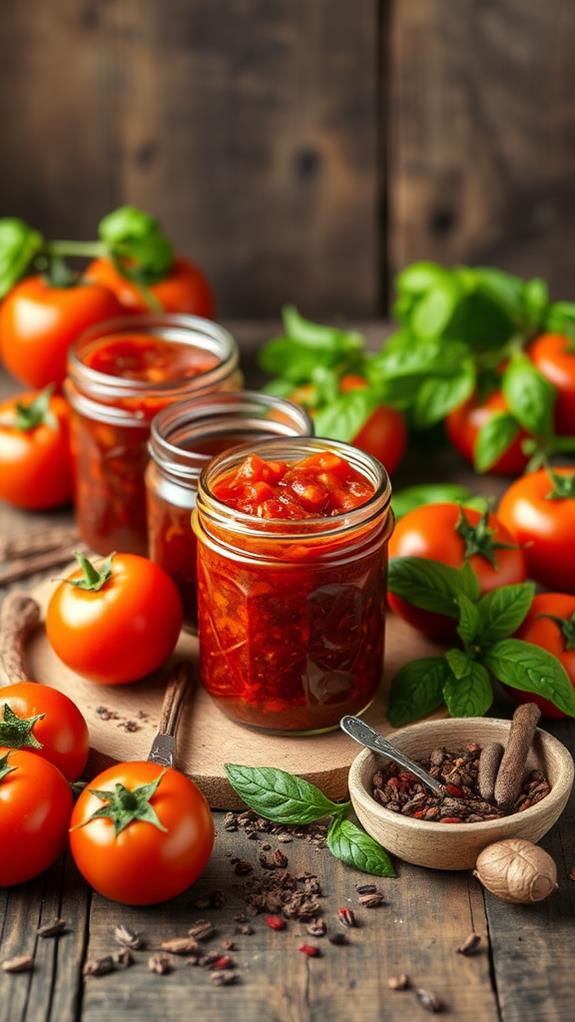
If you've got a surplus of tomatoes, you're in luck. Tomato jam and chutney are two sweet and savory spreads that'll help you preserve those extra tomatoes for months to come. These versatile condiments offer unique flavors and can be used in a variety of dishes, from sandwiches to curries, giving you plenty of options to enjoy your tomato harvest long after summer's end.
Sweet and Savory Spreads
Ever wondered how to transform your leftover tomatoes into something extraordinary? Look no further than sweet and savory spreads like tomato jam and chutney. These versatile preserves offer a delicious way to use up surplus tomatoes while adding unique flavors to your culinary repertoire.
To make tomato jam, you'll combine ripe tomatoes with sugar, spices, and chilies. The result is a sweet and savory spread that pairs wonderfully with:
- Artisanal cheeses
- Grilled or roasted meats
- Crusty breads and crackers
Tomato chutney, on the other hand, incorporates vinegar, raisins, and aromatic spices like cumin, ginger, and mustard seeds. Both preserves allow you to enjoy the taste of fresh tomatoes year-round, offering a creative alternative to traditional sauces or salsa.
When properly canned, tomato jam can last up to a year, while chutney can be refrigerated for 10 days or frozen for up to a year. These preservation methods guarantee you'll always have a flavorful condiment on hand to elevate your dishes. By transforming your leftover tomatoes into jams and chutneys, you're not only reducing waste but also expanding your culinary horizons.
Long-Lasting Tomato Preservation
Tomato lovers rejoice! When you find yourself with an abundance of tomatoes, there are delicious ways to preserve them for long-term enjoyment. Two standout options are tomato jam and chutney, which offer unique flavors and extended shelf life.
Tomato jam, a sweet and spicy condiment, can last up to a year when properly canned. It's a perfect way to savor your harvest well into the winter months. For a different twist, try making Indian-style tomato chutney. This versatile spread combines tomatoes with spices, ginger, and tamarind, creating a balance of tang, sweetness, and heat. You can refrigerate it for up to 10 days or freeze it for a year.
To maximize storage, use air-tight containers or freezer bags. These methods work well for homemade tomato soup, too. Chutney's versatility shines as a sandwich spread, curry accompaniment, or unique dip. Get creative by adding capsicum for a pepper-infused version. By preserving your tomatoes in these flavorful ways, you'll have a tasty reminder of summer's bounty long after the season ends.
Versatile Condiment Options
Culinary enthusiasts know that tomato jam and chutney are more than just ways to preserve your harvest. These versatile condiment options offer a delightful twist to your everyday meals. You'll find that making tomato jam or chutney is both easy and rewarding, allowing you to create unique flavors that complement a wide range of dishes.
To get started with these quick and easy recipes, consider the following:
- Gather ripe tomatoes, sugar, vinegar, and your preferred spices.
- Chop the tomatoes and combine them with other ingredients in a large pot.
- Simmer the mixture until it reaches your desired consistency.
Tomato jam, with its sweet and tangy profile, pairs wonderfully with cheese platters or as a spread for sandwiches. Chutney, on the other hand, offers a more complex flavor profile, often incorporating aromatic spices and herbs. It's an excellent accompaniment to grilled meats or as a dip for appetizers.
Freezing for Future Use
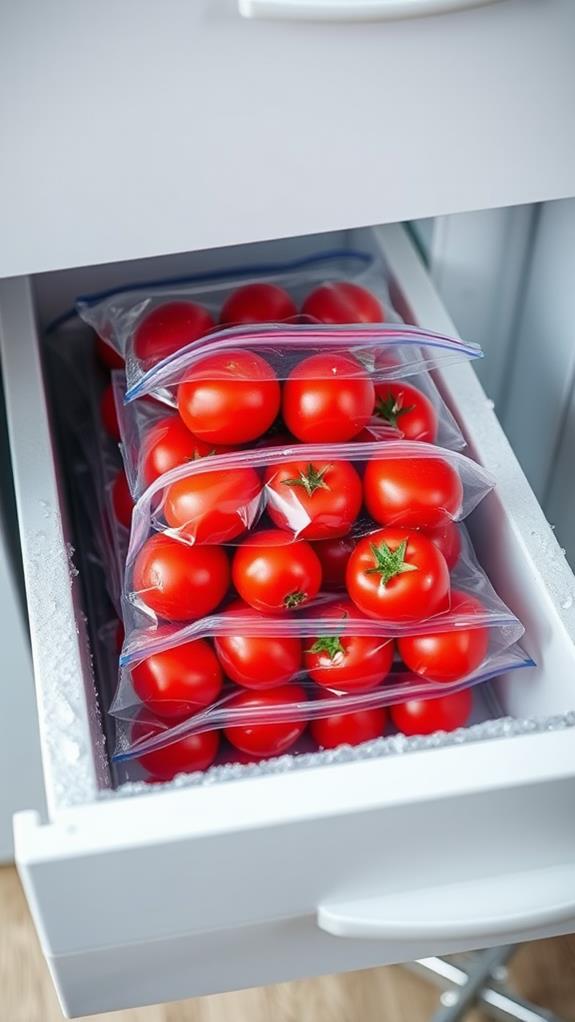
Waste not, want not when it comes to leftover tomatoes. Freezing is an excellent way to preserve your excess harvest for future use. To freeze raw tomatoes, start by blanching, peeling, and arranging them in a single layer on a sheet tray. Pop them in the freezer for 4-6 hours, and you'll have tomatoes that'll keep for up to 6 months.
If you've got prepared tomato sauce or paste, freeze it for up to a year. This makes it easy to incorporate into future dishes without the hassle of starting from scratch. Don't forget about tomato chutney or jam; you can preserve these by canning or freezing, giving them a shelf life of up to a year.
When you're ready to use your frozen tomatoes, they're perfect for soups, stews, and other cooked tomato-based recipes. Utilize frozen raw tomatoes or thawed sauces and pastes to add depth and flavor to your dishes. By freezing your leftover tomatoes, you're not only reducing waste but also ensuring you have a steady supply of this versatile ingredient year-round.
Savory Tarts and Pies
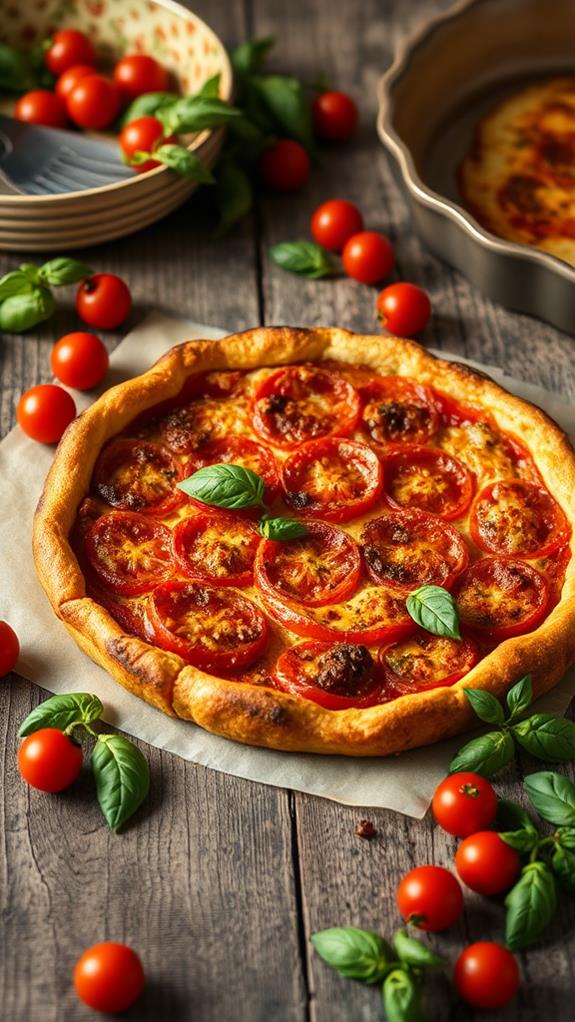
When it comes to utilizing leftover tomatoes, savory tarts and pies offer a delicious solution. Your leftover tomatoes can transform into mouthwatering dishes that'll impress family and friends. Try making a Tomato and Manchego Tarte Tatin, which showcases the best of seasonal tomatoes in a French-inspired upside-down tart. For a quick and easy option, consider an Egg, Bacon and Tomato Tart, where you can prepare the pastry case a day in advance.
If you're looking to use your leftover tomatoes in creative ways, here are three ideas to explore:
- Anchovy, Tomato and Thyme Focaccia
- One-pan Chicken and Prosciutto with Tomatoes, Mozzarella and Basil
- Ricotta and Spinach Cannelloni with Tomato Sugo
These dishes not only make use of your leftover tomatoes but also provide versatile options for different occasions. The focaccia is perfect for bulking up a weekend dinner spread, while the one-pan chicken dish serves as an easy midweek meal. For a comforting pasta option, try the cannelloni, where you can prepare the cheese sauce filling ahead of time for added convenience.
Homemade Tomato Powder
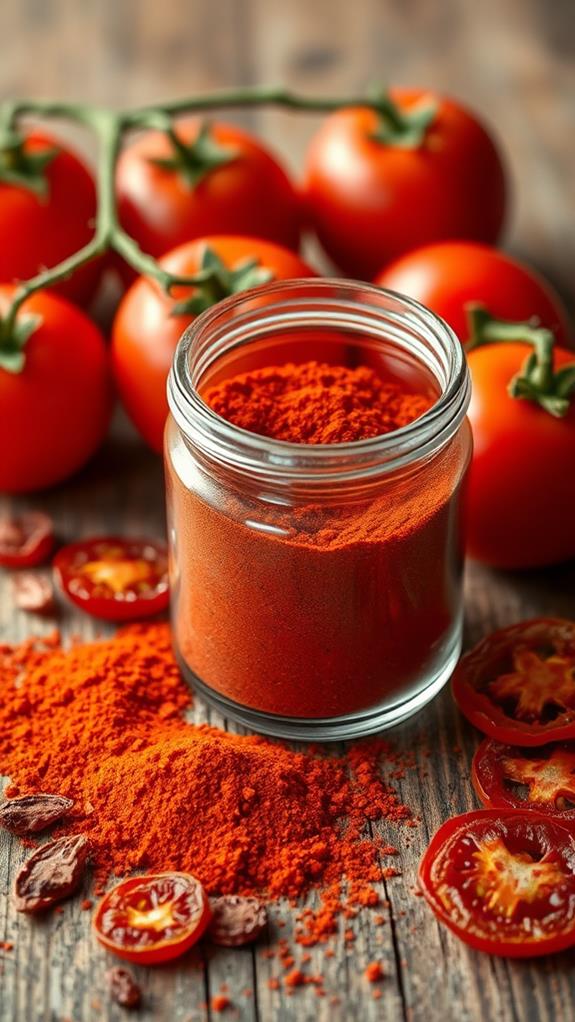
You can transform your excess tomatoes into a versatile, long-lasting ingredient by making homemade tomato powder. This concentrated form of tomato flavor has numerous culinary applications, from seasoning blends to instant sauces. By dehydrating and grinding tomatoes, you'll create a shelf-stable product that retains the essence of fresh tomatoes for months, allowing you to enjoy their taste long after the growing season ends.
Making Tomato Powder
Transforming leftover tomatoes into homemade tomato powder is an excellent way to preserve their flavor and reduce food waste. To make tomato powder, you'll need to dehydrate your leftover tomatoes completely. You can do this by slicing the tomatoes thinly or using just the skins, then drying them in an oven or dehydrator until they're crisp.
Once your tomatoes are fully dehydrated, it's time to grind them into a fine powder. Here's what you'll need:
- Dried tomatoes
- A spice grinder, coffee grinder, or high-powered blender
- An airtight container for storage
Simply process the dried tomatoes in your chosen grinding tool until you achieve a fine, powdery consistency. This homemade tomato powder is incredibly versatile and can be used to add intense tomato flavor to various dishes. You can use it to season soups, stews, sauces, and even baked goods. It's also great for making tomato salt or adding to spice mixes and rubs. Best of all, your homemade tomato powder can last up to a year when stored properly in an airtight container, ensuring you'll always have that delicious tomato flavor on hand.
Uses for Powder
Once you've created your homemade tomato powder, it's time to explore its versatile uses. This concentrated form of tomato flavor can revolutionize your cooking, adding depth and umami to various dishes. Sprinkle it on roasted vegetables or pasta for an instant flavor boost, or mix it with olive oil to create a quick tomato paste when you're in a pinch.
Here's a quick guide to using your tomato powder:
| Dish Type | Usage | Amount |
|---|---|---|
| Rubs & Seasonings | Mix with spices like cumin | 1-2 tsp |
| Soups & Stews | Add for thickening | 1-3 tbsp |
| Dips & Dressings | Blend for flavor | 1-2 tsp |
It's a good idea to experiment with tomato powder in your favorite recipes. Use it to thicken soups without adding extra liquid, or combine it with salt and dried herbs for a DIY seasoning mix. This versatile ingredient can elevate simple dishes like popcorn or baked potatoes, giving them a savory twist. Remember, a little goes a long way, so start with small amounts and adjust to taste.
Storage and Shelf Life
Now that you've explored the many uses for tomato powder, it's important to comprehend how to store it properly to maintain its quality and flavor. When stored correctly, homemade tomato powder can last up to a year, making it an excellent way to preserve overripe tomatoes and reduce food waste.
To safeguard the longest shelf life for your tomato powder, follow these key steps:
- Use an airtight container to protect the powder from moisture and air exposure
- Store the container in a cool, dry place away from direct sunlight
- Label the container with the date of preparation for easy tracking
The shelf life of your tomato powder depends on several factors, including the drying method, storage conditions, and initial tomato quality. By using a dehydrator or oven to dry tomato skins thoroughly before grinding, you'll create a powder with minimal moisture content, which helps prevent spoilage. Remember to check your tomato powder periodically for any signs of mold or off-odors, and discard it if you notice any changes in appearance or smell. With proper storage techniques, you'll be able to enjoy your homemade tomato powder in various dishes for months to come.
Tomato-Based Cocktails

Bartenders and home mixologists alike have discovered the versatile potential of leftover tomatoes in cocktails. If you've got a surplus from your farmers market haul or an abundance of cherry tomatoes, creating tomato-based drinks is a great way to use them up. You can start with classics like the Bloody Mary or Michelada, which utilize tomato juice as a key ingredient. For a more creative approach, try making your own tomato juice or purée to use as a base for drinks like the Tomato Gin Fizz or Tomato Margarita.
To add sophistication to your cocktails, consider extracting tomato water by chopping and straining tomatoes. This liquid can be used to infuse spirits and liqueurs with a subtle tomato flavor. If you're feeling adventurous, try grilling or roasting your tomatoes before blending them into drinks for a smoky, caramelized taste. You can also experiment with tomato-based shrubs, syrups, or even tomato-infused salt to enhance the tomato notes in your cocktails. These techniques will help you transform your leftover tomatoes into unique and flavorful drinks that are sure to impress.
Stuffed Tomatoes

Stuffed tomatoes offer a savory alternative to using leftover tomatoes in drinks. This versatile dish allows you to transform excess tomatoes into a delicious appetizer or light main course. To create stuffed tomatoes, you'll need to hollow out the fruit, leaving a firm texture for the shell. You can then fill these shells with a variety of ingredients, customizing the stuffing to suit your taste preferences or dietary needs.
Spicy tomato rice with ground beef
Herb-infused breadcrumbs and cheese
Mediterranean-style quinoa with feta
When preparing stuffed tomatoes, consider the cooking method that best complements your filling. You can bake them in the oven for a warm, comforting dish, grill them for a smoky flavor, or serve them chilled for a chilled summer meal. For a unique twist, you can even crack an egg into the tomato before baking, creating a breakfast-inspired version.
Stuffed tomatoes not only help you reduce food waste but also provide a visually appealing and flavorful way to enjoy your leftover produce. By experimenting with different fillings and cooking techniques, you'll discover countless variations of this versatile dish.
Tomato Bread Salad
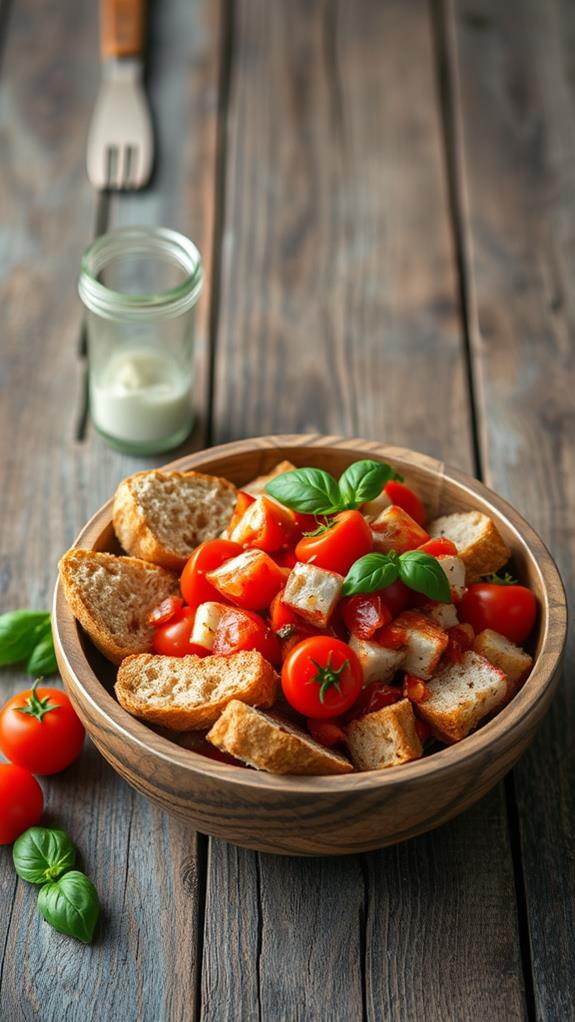
Panzanella, a classic Italian tomato bread salad, offers a delicious solution for using up leftover tomatoes and stale bread. If you grow tomatoes in your garden, you'll often find yourself with an abundance of ripe fruits. This versatile dish allows you to use leftover tomatoes and bread in an invigorating way.
To create panzanella, you'll need to cube stale bread and mix it with juicy tomato slices. The bread soaks up the tomato juices, creating a flavorful base for the salad. You can customize your panzanella by adding various ingredients and dressings:
| Base Ingredients | Optional Additions | Dressing Options |
|---|---|---|
| Stale bread | Onions | Olive oil |
| Ripe tomatoes | Capers | Balsamic vinegar |
| Fresh basil | Cucumbers | Red wine vinegar |
This light and vibrant salad can be enjoyed as a main course or a side dish. It's an excellent way to reduce food waste and make the most of your garden's bounty. By utilizing leftover tomatoes and stale bread, you're not only creating a delicious meal but also practicing sustainable cooking habits.
Frequently Asked Questions
What Can I Do With Excess Tomatoes?
If you've got excess tomatoes, you've got options! You can make a hearty tomato sauce, perfect for pasta dishes or as a base for soups. Slice them for sandwiches or salads, or try roasting them to intensify their flavor. Canning is a great way to preserve your bounty for later use. You could also whip up a batch of fresh salsa or gazpacho. Don't forget about tomato jam or chutney for a unique spread. With these ideas, you'll make the most of your tomato surplus.
What to Do With Tomatoes Before They Go Bad?
Imagine your tomatoes as a ticking clock, their vibrant hues fading with each passing moment. To halt time's relentless march, you've got options. You can freeze them whole after blanching and peeling, or transform them into a savory sauce for future use. Consider whipping up a spicy Indian chutney or a tangy tomato jam. Don't forget the skins; dry them to create a flavorful powder. These methods will extend your tomatoes' lifespan, ensuring you'll savor their essence long after their prime.
Can I Freeze Leftover Tomatoes?
Yes, you can freeze leftover tomatoes. Here's how: First, blanch and peel them. Then, arrange the tomatoes in a single layer on a sheet tray and freeze. Once frozen, transfer them to a freezer-safe container. You can use these frozen tomatoes in cooked dishes like soups, sauces, and stews. If you've made tomato sauce, you can freeze that too. For longer storage, consider making tomato paste by reducing the sauce in a low-temperature oven before freezing.
What Can I Do With a Bounty of Tomatoes?
Like a gardener's dream come true, a bounty of tomatoes offers endless possibilities. You can preserve them by freezing, canning, or turning them into sauces and salsas. Roast them to intensify their sweetness for pastas or bruschetta toppings. Create chilled soups like gazpacho or vibrant salads. Bake them into savory tarts, pies, or quiches. For a unique twist, try making tomato sorbet or chutney. These versatile options guarantee you'll enjoy your tomato harvest year-round, minimizing waste and maximizing flavor.





